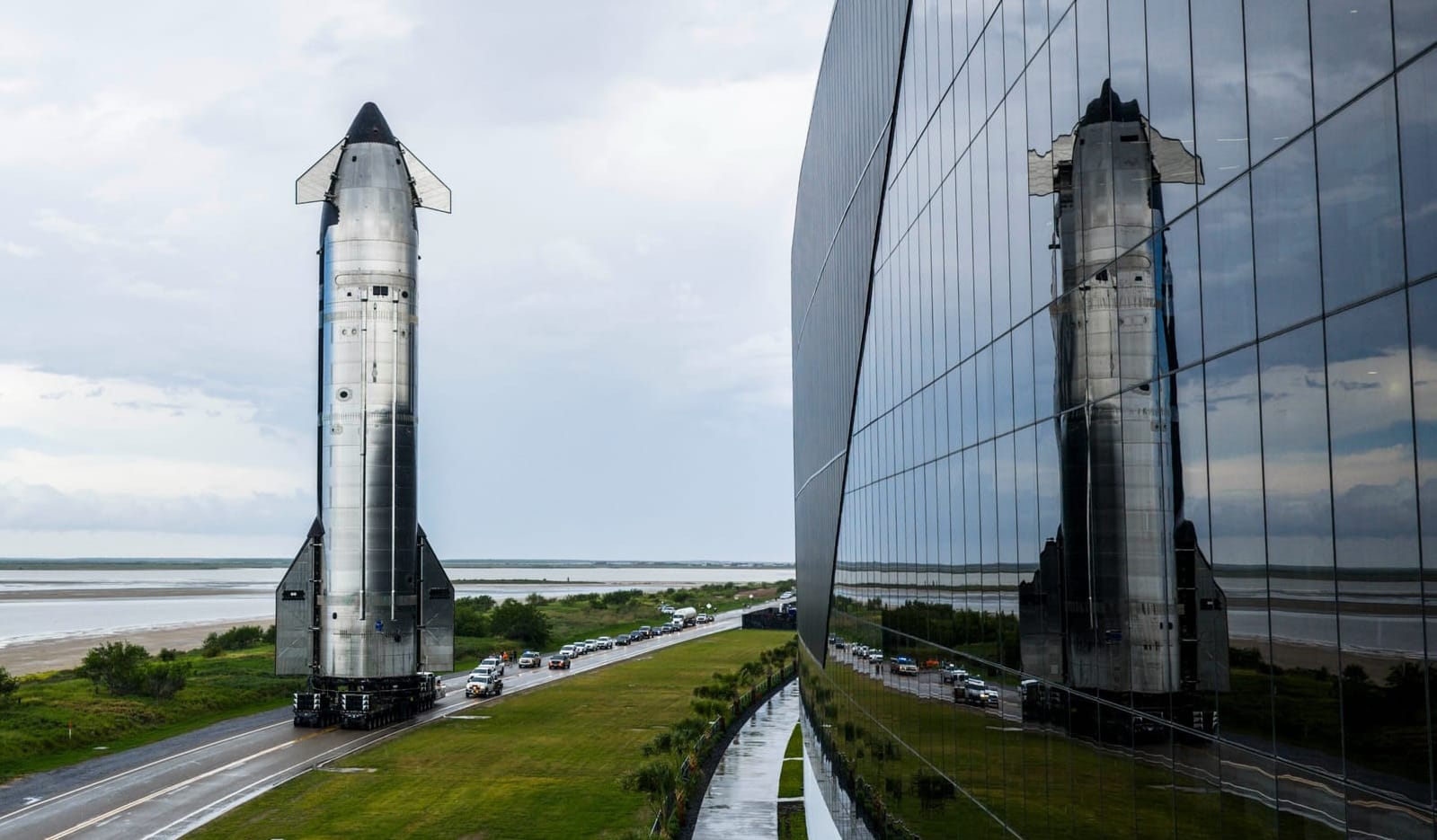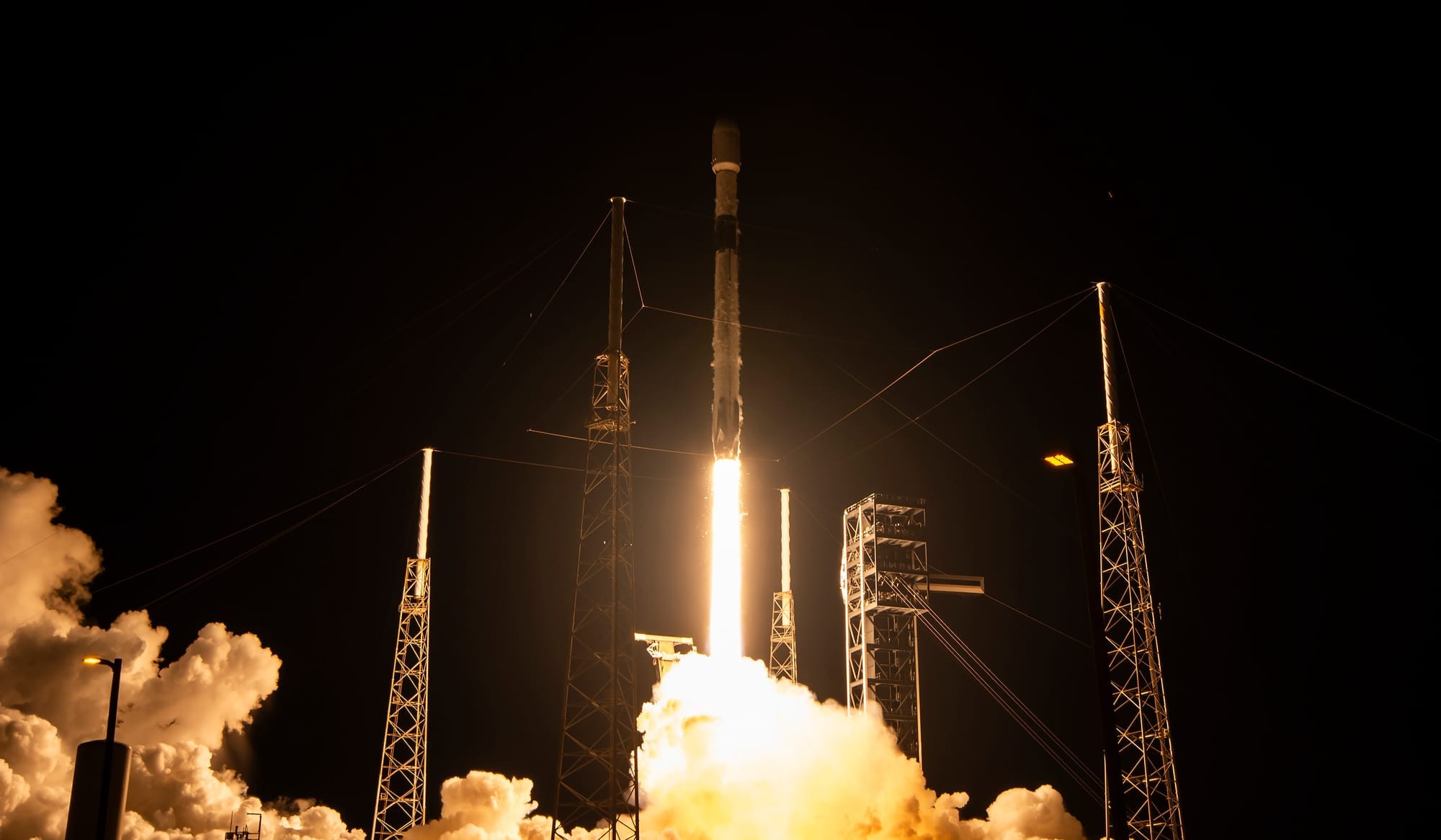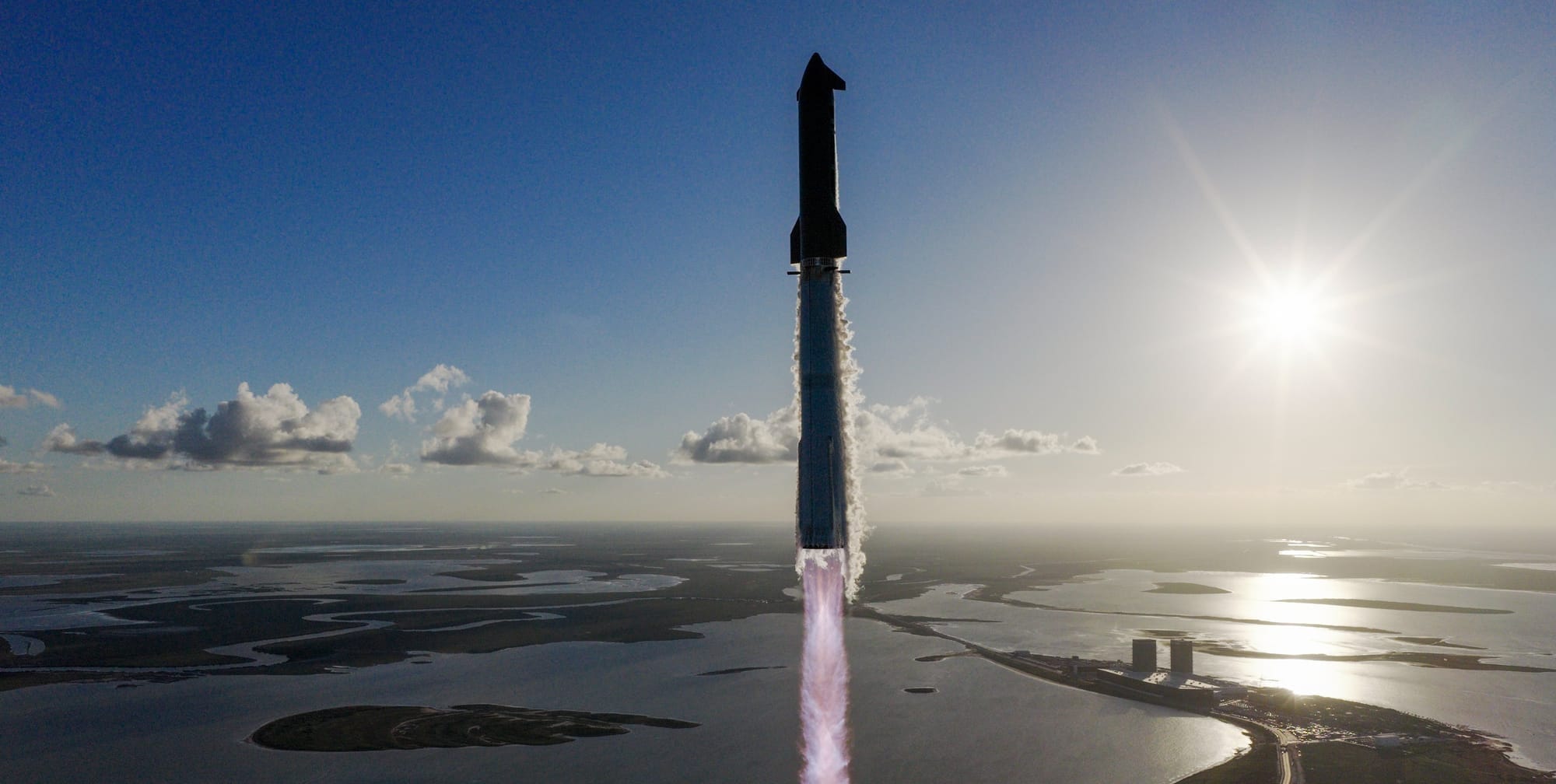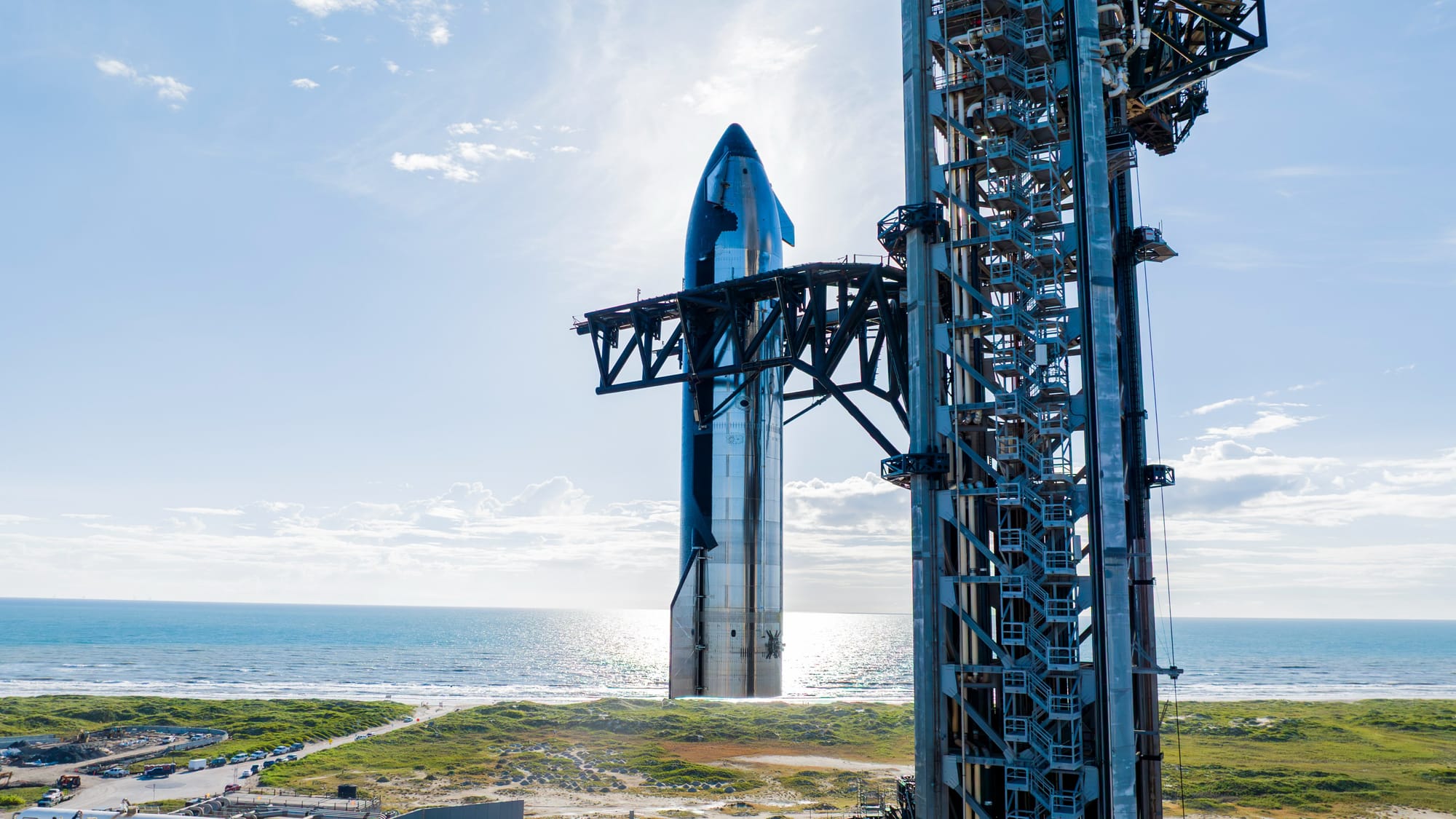Table of Contents
SpaceX has performed Starship-Super Heavy's latest flight test, for its first largely successful launch this year.
Last week, SpaceX shared that Ship 37 and Super Heavy Booster 16 were performing this flight test, both making their first flights. Details provided by the company stated that Ship 37 could release eight dummy Starlink satellites and aim to perform an in-space burn, while Booster 16 would splash down in the Gulf of Mexico to perform reentry experiments.
The tenth flight test had previously attempted to begin late on August 24th and 25th, standing down due to propellant loading issues and weather, respectively. On August 26th, the flight test occurred.
Under the power of thirty-three Raptor engines, Booster 16 lifted off from the Orbital Launch Mount, carrying Ship 36 up towards space. During ascent, one engine shut down early at T+1:33.
Liftoff of Starship! pic.twitter.com/d6d2hHgMa0
— SpaceX (@SpaceX) August 26, 2025
Starship-Super Heavy lifting off from Starbase, Texas, for its tenth flight test, via SpaceX on Twitter.
With a mostly nominal ascent, Booster 16 pitched downrange to bring the vehicle towards its staging position, shutting down all but three of its engines to do so. At T+2:50, Ship 37 lit its three sea-level and three vacuum Raptor engines to hot-stage off of the booster.
Starship’s Raptor engines ignite during hot-staging separation. Super Heavy is boosting back towards its splashdown site pic.twitter.com/9fRi4kvbmX
— SpaceX (@SpaceX) August 26, 2025
Ship 37 hot-staging from Super Heavy Booster 16, via SpaceX on Twitter.
During hot-staging, Booster 16 performed its flip and began its boostback burn, relighting nine of the ten engines needed, with the failed engine remaining off. Despite being one engine short, the boosterback burn was performed as needed, then jettisoning the hot-staging ring.
Super Heavy has splashed down in the Gulf pic.twitter.com/LGozUAmLt8
— SpaceX (@SpaceX) August 26, 2025
Super Heavy Booster 16 splashing down in the Gulf of Mexico, via SpaceX on Twitter.
Now without its hot-staging ring, Booster 16 descended toward the Gulf, relighting twelve engines to slow its ascent, then dropping down to three engines (two center and one mid-ring), before leaving two engines running to hover about two hundred meters up. Afterwards, the last two engines shut down to drop Booster 16 onto the ocean surface, ultimately exploding.
Open the pod bay door, HAL
— SpaceX (@SpaceX) August 26, 2025
Starship deploying @Starlink simulator sats pic.twitter.com/3CSOyulzcJ
Ship 37 deploying dummy Starlink satellites during its coast phase, via SpaceX on Twitter.
While the Super Heavy Booster 16 was heading down, Ship 37 was heading up into space, reaching engine cutoff as planned. During its coast through space, Ship 37 deployed eight dummy Starslink satellites from its 'Pez dispenser', for Starship-Super Heavy's first payload deployed into space (but flying on the same suborbital trajectory), and performed a short in-space Raptor burn.
Starship successfully ignited one of its Raptor engines while in space pic.twitter.com/SNmzyygPBC
— SpaceX (@SpaceX) August 27, 2025
Ship 37's in-space Raptor burn, via SpaceX on Twitter.
During the coast phase, however, something, it's unclear what, appeared to blow up randomly in the engine section.
Something in the aft blew up 😳 pic.twitter.com/NZgyZQFsCx
— Proxima Report (@proximareport) August 27, 2025
Something explodes in the engine section of Ship 37, via Proxima Report on Twitter.
Live views brought to you by @Starlink pic.twitter.com/3yVzQrMZBz
— SpaceX (@SpaceX) August 27, 2025
Ship 37 passing through reentry, via SpaceX on Twitter.
For the first time this year, Starship reached atmospheric reentry under its own control, successfully passing through peak heating and maximum stress. During the reentry, the aft flaps suffered from extensive burn-through, but managed to retain control.
Splashdown confirmed! Congratulations to the entire SpaceX team on an exciting tenth flight test of Starship! pic.twitter.com/5sbSPBRJBP
— SpaceX (@SpaceX) August 27, 2025
Ship 37 splashing down in the Indian Ocean, via SpaceX on Twitter.
Following a toasty reentry, burning off much of the heat shield, Ship 37 began its atmospheric descent in its bellyflop position for several minutes. Moments before hitting the Indian Ocean, three sea level Raptors reignited for the 'flip-and-burn', bringing the vehicle to a soft splashdown. Seconds later, the vehicle fell sideways and exploded.
Back on Track?
With Ship 37 making it through to a largely successful splashdown and Booster 16 demonstrating the desired reentry and landing tests, Starship-Super Heavy is heading back towards being on track. Although only one more 'Block 2' Starship is left to fly, before another new version of the vehicle is switched to, possibly for a repeat of today's flight. It remains to be seen if a 'Block 3' Starship will head straight into orbit, but the upper-stage requires a brand new version of the Super Heavy Booster, a new launch pad at Starbase, and the still-in-development Raptor-3 engines.
2025 had previously been poised to be a key year for the Starship program with a Ship-to-Ship propellant transfer demonstration for NASA. The propellant transfer between two vehicles is critical for getting the Starship lunar lander out to the Moon, and returning American astronauts to the surface through the Artemis program.
Shortly after the end of the flight test, Acting NASA Administrator Sean Duffy took to Twitter to say:
"Congratulations to SpaceX on its Starship test. Flight 10's success paves the way for the Starship Human Landing System that will bring American astronauts back to the Moon on Artemis III."
However, during the three launch attempts for the tenth flight test, no mention of Starship's crewed lunar lander variant was made or of NASA's Artemis program. In contrast, dozens of mentions of missions to Mars were made.
In the first half of the year, the Starship program had regressed significantly in terms of progress. In June, Ship 36 unexpectedly exploded during a routine test, wiping out a critical pre-flight test stand with it. Meanwhile, during flight tests of the vehicle, Ship 33 was lost due to a fire in its engine section in January. Next in March, Ship 34 was again lost in a fire. Then in May, Ship 35 was destroyed during atmospheric reentry following leakages across the vehicle.
What is Starship-Super Heavy?
Starship-Super Heavy is SpaceX's in-development fully reusable super heavy-lift launch vehicle and the largest rocket currently flying. SpaceX is currently aiming to have the launch vehicle deliver one-hundred and fifty tons to low Earth orbit while reused or two-hundred and fifty tons when expended, although there are rumors from SpaceX of an expendable payload capacity of three-hundred tons.
On the launch pad, Starship-Super Heavy is one-hundred and twenty-four meters tall and weighs 5,000,000 kilograms fully fuelled. The diameter of both vehicles is nine meters, excluding aerodynamic control surfaces.
What is Starship?

Starship is the second-stage of the Starship-Super Heavy launch vehicle and is planned to be capable of multiple missions into orbit, after a short refurbishment. The vehicle is fifty meters tall and nine meters in diameter, excluding its four aerodynamic control surfaces. Fully fuelled with liquid methane and liquid oyxgen Starship is believed to weigh 1,300,000 kilograms with an approximate weight of 100,000 kilograms unfuelled.
The Starship second-stage is powered by three sea-level Raptor engines along with three vacuum-optimized Raptor engines. These sea-level engines are believed to generate 230 tons of thrust each with the vacuum-optimized engines generating 258 tons of thrust each for a total combined 1,500 tons of thrust for Starship. The vacuum-optimized Raptors are unable to gimbal requiring the sea-level Raptors for control of the second-stage on ascent and landing.
In order to survive re-entry for reuse, Starship has several thousand thermal protection tiles on one side of the vehicle and on all four of its aerodynamic control surfaces. The four control surfaces help guide the vehicle during re-entry and prior to landing inside the atmosphere at a pre-determined location. Starship also has a series of small thrusters to control the vehicle in space before re-entry.
SpaceX is believed to be working on a few variants of Starship for use as a Moon lander, propellant tanker, space station, Mars lander, and as a crewed spacecraft.
What is Super Heavy?

Super Heavy, also called 'the Super Heavy booster', is the first-stage of SpaceX's Starship-Super Heavy launch vehicle. The giant Super Heavy first-stage is planned to be capable of multiple flights per day with minimal refurbishments and inspections. The vehicle is seventy-one meters tall and nine meters in diameter, excluding its four grid fins and chines. Fully fuelled with liquid methane and liquid oyxgen Super Heavy is believed to weigh 3,600,000 kilograms with an approximate mass of 200,000 kilograms unfuelled.
The Super Heavy first-stage is powered by thirty-three sea-level Raptor engines generating a combined thrust of 7,590 tons, with each engine generating 230 tons of thrust. The outer twenty Raptor engines are unable to gimbal with the inner thirteen being able to for control of the first-stage.
To enable the reuse of Super Heavy, the vehicle has four large grid fins placed in the interstage to assist in guiding and controlling during descent. Super Heavy also has four chines running along the lower third of it to generate lift and assist in stabilization.
Shortly after completing the ascent, Super Heavy relights ten engines, as three were running during staging, and performs a 'boost back' burn in order to return to the launch site. After the 'boost back' burn is completed the engines shut down with Super Heavy being guided by a series of small thrusters and its grid fins. Once Super Heavy is at the correct altitude above its landing location three engines start back up for the landing burn. SpaceX currently plans to have Super Heavy land back at the launch site, or at sea if a problem is detected during descent
Super Heavy also features a hot-staging ring atop of it to allow for a faster and simpler staging process, according to SpaceX. The hot-staging ring has dozens of gaps on the sides to allow for the Raptor engine exhaust of Starship to escape.






